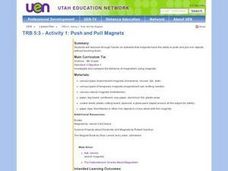Curated OER
Science: Discovering Earth's Air Prressure
Fourth graders discover earth's air pressure through observation of several experiments. In the "Experiment of the Leaky Bottle," they observe how air pressure forces water out of the lowest hole farther than the holes above it. In...
Curated OER
Science: The Changing Life of Air Pressure
Fourth graders observe demonstrations how heated air rises and becomes a low pressure area. After watching several teacher-conducted experiments, 4th graders, in groups, discuss and answer questions in their journals. Finally, they...
Curated OER
Fuel and Air Relationships
Students use EngineSim and information found on the World Wide Web to complete the activity on the relationship between the atmosphere and jet fuel. They discover how much air is required to pass through a jet engine.
Curated OER
Causal Patterns in Air Pressure Phenomena
Students explore a scientific concept to obtain understanding by performing an experiment. The inquiry can be done in groups or as a whole class. The outcome is that students can use models to obtain futher understanding.
Curated OER
Air Quality Trivia Time
Students identify and analyze what the Air Quality Index (AQI) is and how it works. They review ways that "unhealthy" or "hazardous" days could be prevented and draw and color something that they can do to help reduce air pollution....
Curated OER
Air Quality and Transportation
Second graders study about air pollution and the effects it has on our Earth. Students tally cars on a sheet that has been categorized as follows: One person in car, two persons in car, or three or more persons in car. Students go to...
Curated OER
Science-Unit on Matter-Gases
First graders understand that gases take up space even though you can't see or smell it. This is done through many experiments like trapping air in different sized bags, using balloons and plastic bottles, and blowing bubbles. They...
Curated OER
Global Change — Change and Cycles Where Land, Air and Water Meet
Learners participate in an experiment to define a parts-per-billion solution. In this ecology lesson plan, students select a second substance to create a parts-per-billion solution and observe and record their results. Learners work in...
Curated OER
Aviation, Aeronautics and Aerodynamics
Students investigate the physics of flight through various experiments. In this physics lesson, students construct different flying objects. They explain the dynamics that make these object fly.
Curated OER
Hurricanes
Students perform various experiments to explore hurricanes. In this earth science lesson, students explain how they form. They identify the structure of a hurricane.
Curated OER
Understanding: Flight
Students review the principles of flight before performing a series of simple experiments. Working in small groups, they complete hands-on activities that demonstrate the principles that make it possible for an airplane to lift into air...
Curated OER
Principles of Flight: Bernoulli's Lift
Students discover how air pressure effects flight. In this physics activity, students create two types of airplane wings so they can observe the way air pressure creates lift. Students utilize a printout to create the...
Curated OER
Hovercraft Racers!
Students gain first-hand experience on how friction affects motion. They build a hovercraft using air from a balloon to levitate a craft made from a compact disk (CD), learning that a bed of air under an object significantly reduces the...
Curated OER
Why Is My Bread Fuzzy?
Students explore the organisms that live on counters or surfaces in the classroom. In this mold experiment, students observe mold in different conditons. Students record their observations on a worksheet. Students understand how...
Curated OER
Push and Pull Magnets
Fifth graders pull a paper clip sitting on paper with a magnet beneath the paper. They experiment to see what happens if they substitute the paper with thicker paper and other materials (plywood, glass, foil, etc.)
Curated OER
What Plants Need in Order to Survive and Grow: Light
Students conduct an experiment to evaluate whether plants need light to survive and grow. They observe and gather data about plant responses to different growth regimes, analyze the data, and make conclusions about basic plant needs.
Curated OER
Sampling Carbon Dioxide
Students perform an experiment to determine which source of gas (their breath, exhaust from a car, or the air in the classroom) has a greater concentration of carbon dioxide. Students compare the colors of BTB solutions after...
Curated OER
What Plants Need in Order to Survive and Grow: Soil
Students conduct an experiment to evaluate whether plants need soil to survive and grow. They plant two seeds, one with soil and one without, make predictions, and record and analyze the seed germination results on a worksheet.
Curated OER
Where We've Been and Where We're Going
Students travel with Christa McAuliffe through space demonstrations. In this space activity, students follow through the past to the present air travel. Students understand the benefits and problems associated with zero gravity and how...
Curated OER
Fun with Surface Tension!
Students explore physical science by participating in a water properties experiment. In this surface tension lesson, students utilize pennies, water, a dropper and soapy water to test the different surface tensions with numerous objects....
Curated OER
Activity Plan 5-6: Where Does the Water Go?
Students perform an experiment to discover what happens to water as it evaporates. In this early childhood lesson plan, students observe evaporation as they conduct an experiment. Students fill cups with water, then check it daily for...
Curated OER
Electrical Generators
Young scholars study what an electric generator does and its history. In this energy lesson students complete several experiments including building their own electric generator.
Curated OER
Plant Transpiration
Students conduct various experiments to investigate plant transpiration. In this biology lesson, students explain how this process helps maintain the hydrologic cycle. They measure the rate of water loss in plants using a potometer.
Curated OER
The Urban Heat Island Effect - Lesson 2 (Grade 5)
Fifth graders use the scientific process to examine how when various surfaces are exposed to similar environmental conditions, surface temperatures may vary. They conduct an experiment to show the relationship between surface and...























